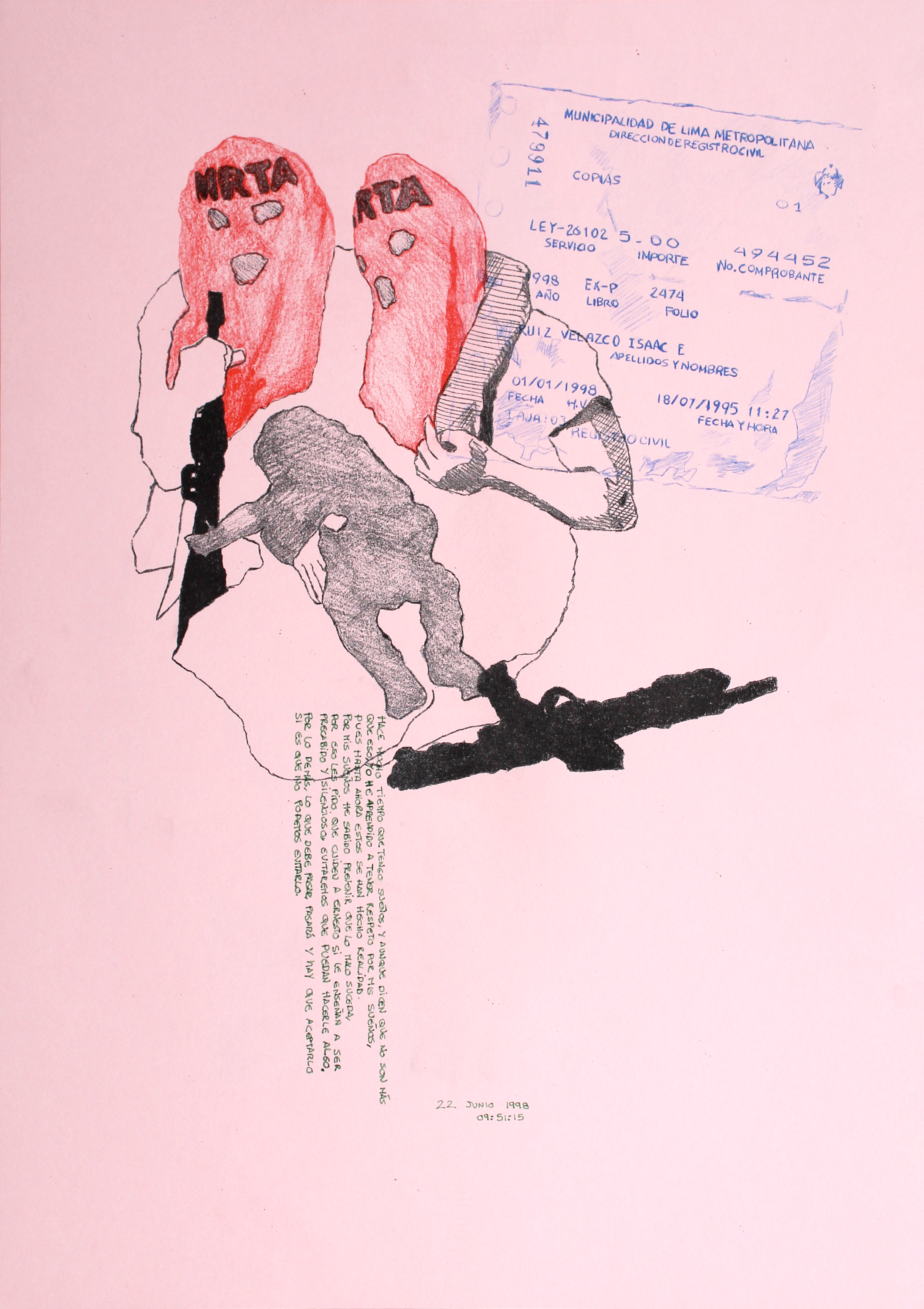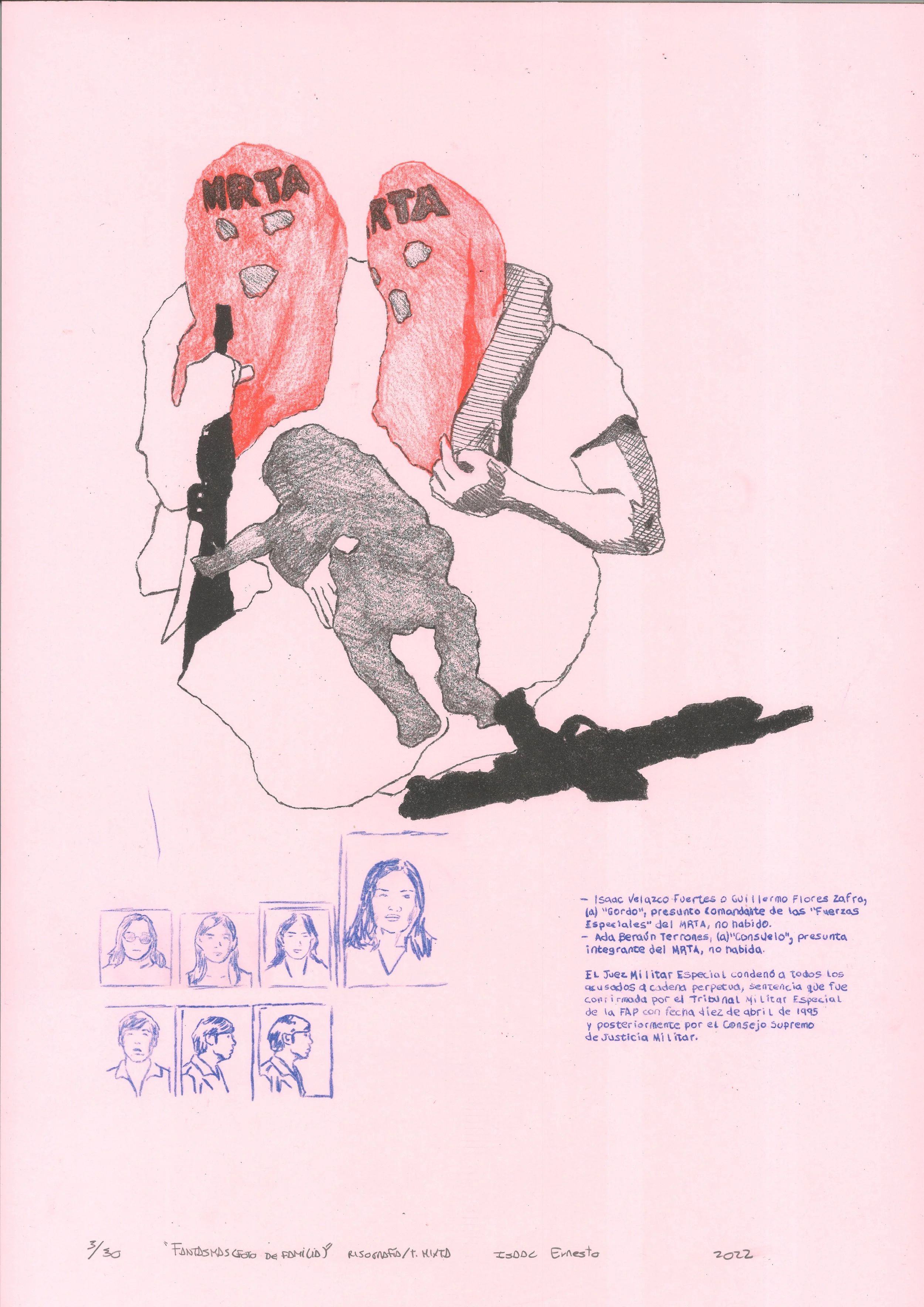Fantasmas (foto de familia)
Colecciones privadas - dispersas de forma individual
"Fantasmas (foto de familia)" parte de la icónica fotografía de Vera Lentz, capturada en los años de violencia política en Perú, donde una pareja encapuchada del MRTA sostiene a su hijo entre armas y un entorno doméstico. Esta imagen, difundida en el artículo titulado Los niños de la guerra, de Eduardo Toche, es intervenida para desarticular su lugar en el archivo mediático y reclamarla como espejo de una memoria personal. Alrededor de la fotografía, se despliegan fragmentos de diarios íntimos, documentos policiales y partidas de nacimiento del propio artista, entrelazados con copias desdibujadas de la escena original. La obra construye así un álbum familiar alternativo, donde lo doméstico se confunde con lo clandestino, y la crianza se enreda en los hilos de la militancia subversiva.
La operación no es solo estética, sino política: al situar su propia historia como hijo de militantes en diálogo con la imagen de Lentz, el artista confronta el relato hegemónico que omite o criminaliza las herencias incómodas. Los documentos oficiales —actas de nacimiento, informes de inteligencia— se vuelven huellas de un Estado que registra, persigue y borra, mientras los diarios fragmentados exponen la intimidad de crecer entre silencios y secretos. La fotografía, ahora intervenida, ya no es un documento de “lo terrorista”, sino un retrato fantasma que interroga: ¿cómo se habita un país que niega tu existencia? La respuesta no está en la imagen, sino en sus grietas: en el niño que carga el peso de su nombre, en los papeles que certifican una vida bajo sospecha, en el acto de nombrar, como resistencia, lo que otros prefieren dejar en la penumbra.
Ficha
Risografía, lápiz de color y tinta sobre cartulina rosa.
42,3 x 32,9 cm c/u (16 en total)
Ghosts (Family Photo)
Private collections — individually dispersed
"Ghosts (Family Photo)" begins with the iconic photograph by Vera Lentz, captured during the years of political violence in Peru, where a hooded couple from the MRTA holds their child amidst weapons and a domestic setting. This image, published in Eduardo Toche’s article The Children of the War, is here intervened to dismantle its place in the media archive and reclaim it as a mirror of personal memory. Surrounding the photograph are fragments of intimate diaries, police records, and the artist’s own birth certificates, interwoven with blurred copies of the original scene. The work thus constructs an alternative family album, where the domestic merges with the clandestine, and parenting becomes entangled in the threads of subversive militancy.
This operation is not only aesthetic, but political: by placing his own history as the child of militants in dialogue with Lentz’s image, the artist confronts the hegemonic narrative that either omits or criminalizes uncomfortable inheritances. Official documents—birth certificates, intelligence reports—become traces of a state that records, persecutes, and erases, while fragmented diaries reveal the intimacy of growing up amidst silences and secrets. The photograph, now intervened, is no longer a document of “the terrorist,” but a ghostly portrait that asks: how do you inhabit a country that denies your existence? The answer lies not in the image, but in its cracks: in the child who bears the weight of his name, in the papers that certify a life under suspicion, in the act of naming—as an act of resistance—what others prefer to keep in the shadows.
Ficha
Risograph, colored pencil, and ink on pink cardstock
42.3 × 32.9 cm each (16 pieces total)















